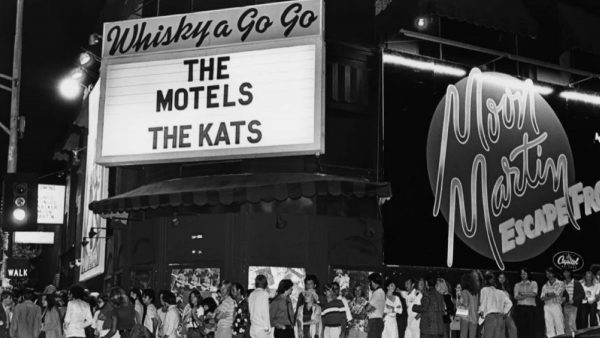
My Montgomery, Alabama, high school was conveniently located next door to a Sears store where I regularly shopped for vinyl records. This is where I found the 1964 album “Johnny Rivers Live at the Whisky-a-Go-Go,” which was my introduction to the singer’s unique brand of updated rockabilly. As I listened to this album and the ones that followed, I vowed that someday I would move to L.A. and see Rivers at the Whisky.
The Whisky-a-Go-Go was the brainchild of Elmer Valentine, Shelly Davis, Phil Tanzini, and Theodore Flier, inspired by the discotheques trending in Paris in the early sixties. The club opened in an old Bank of America building on the corner of Sunset Blvd. and Clark Street in January 1964 and was an instant hit. Celebrities like Jayne Mansfield flocked to hear driving sets by Johnny Rivers and his band and ogle the hip-shaking go-go dancers that performed in cages overhead during breaks, moving to records spun by a female DJ.
On the inside, the Whiskey is just a big, dark room with a capacity of 500 and a narrow staircase leading to the dressing rooms upstairs but no other club is so steeped in musical history. In the late sixties, the Whisky became the go-to place for checking out the hottest new bands like the Byrds, Love, Buffalo Springfield, and the Doors, who got fired for the racy content of one of their songs. The Whisky was a flashpoint for the 1966 Sunset Strip riots which inspired Steven Stills of the Buffalo Springfield to write “For What It’s Worth.”
Alas, by the time I moved to WeHo in 1971, Rivers had moved on but I did start visiting the club frequently, seeing acts like pioneering all-female group Fanny and my longtime favorite Little Richard, who was enjoying a comeback on a new label. At the time, the Whisky and the Troubadour were the local hot spots for pop/rock/folk acts while local hard rockers kept Gazzarri’s jumping, and touring country acts stopped at the Palomino in North Hollywood. In 1973, they were joined on the Strip by the Roxy, which became the go-to club for labels showing off their acts.
In the following decades, the Whiskey became a mecca for aspiring heavy metal bands, who moved to SoCal in their quest for stardom, or at least a label deal. These were the days of pay-to-play when acts had to purchase tickets to get a gig at a hot club, then sell as many of them as possible to friends, family, and fans. You could see these young musicians walking up and down the Strip, stapling their band’s flyers over those of rival acts. A few of them made it big, like Motley Crue, who had a crash pad up the hill on Clark where they invited fans and groupies to party after their shows at the Whiskey.
No, I never got to see Johnny Rivers play the Whisky but did catch him several times in the 70s at theme parks and in the 90s at the House of Blues. In 2014, Rivers returned to the club to celebrate its 50th anniversary. Clubs come and go, but the Whisky is one of the few to remain open and relevant for more than 50 years in the same location.

Thank you Linda.
[…] Source link […]
Johnny’s bass player was Joe Osbourne and his drummer was Mickey Jones. Not too shabby!
Johnny always had the best musicians. My old friend Keith Allison was his bandleader when he was touring in the 70s.